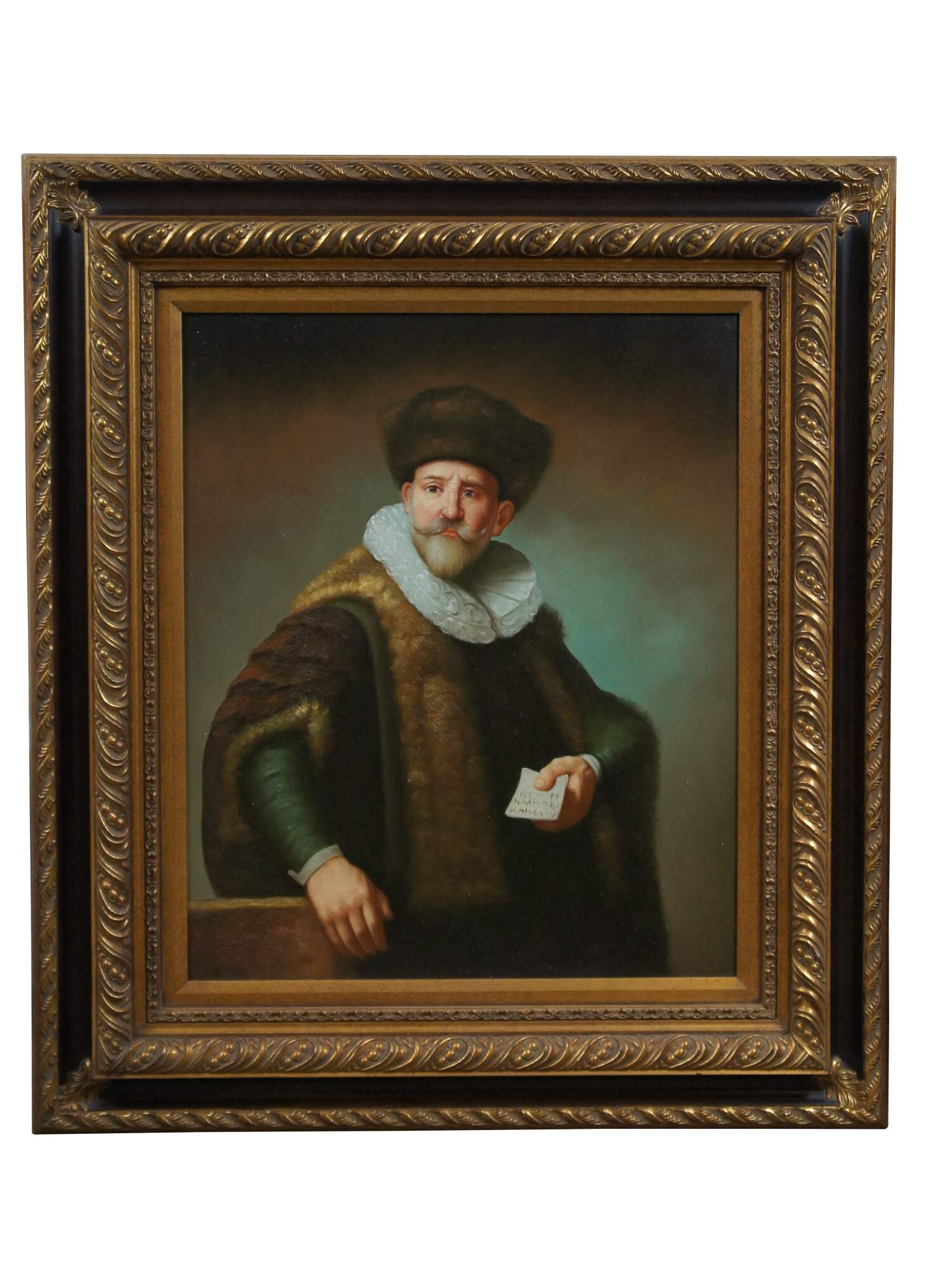
Shipping:
Free Shipping Included
Delivery:
Estimated 2-15 Business Days
Payments:
Credit Card, Check, Cash, PayPal, Apple Pay, Venmo
Returns:
30 Days 100% Money Back Guarantee, Buyer Pays Return Shipping
Description
Late 20th century hand painted reproduction oil on canvas painting after “Portrait of Nicolaes Ruts” originally painted in 1631 by Rembrandt van Rijn. This portrait of a fur trader was one of Rembrandt's earliest commissioned pieces and helped launch his career as a portrait painter. Displayed in a carved gilded and ebonized frame.
Portrait of Nicolaes Ruts (1573–1638) is a 1631 painting by the Dutch artist Rembrandt van Rijn. It is one of Rembrandt's earliest commissioned pieces and helped launch his career as a portrait painter. The painting is housed in the Frick Collection.
In it, Ruts is depicted wearing a type of robe (known as a tabbaard) with a sable lining; a translucent neck ruff; and Russian ushanka hat. He holds a note in his proper left hand and looks directly at the viewer; his right hand rests on the back of a red chair. The text of the note Ruts is holding in the portrait is illegible, except for the date of 1631.
Nicolaes Ruts (1573–1638), the subject of the portrait, was born in Cologne and became an Amsterdam Mennonite merchant who frequently traded with the Russian colony at Arkhangelsk. Rembrandt painted the portrait of him in 1631, when Ruts was 58 years old. As a merchant, Ruts was not particularly successful, and filed for bankruptcy shortly before he died. The portrait may have been commissioned by his daughter Susanna who, together with her husband, was quite a successful Amsterdam merchant.
“Rembrandt was born in Leyden on July 15, 1606. In 1620 he became a student at the Latin School of Leyden University, but soon gave up his formal education to enter the studio of Jacob van Swanenburch. He continued his instruction in Amsterdam with Pieter Lastman and then Jan Pynas. In 1626 he returned to Leyden, an independent master, and entered into partnership with Gerald Dou (1628). Three years later he settled in Amsterdam, where he remained until his death. In that city his first big portrait group, ""The Anatomy Lesson of Dr. Nicolaes Tulp"" gained him immediate recognition and a fashionable portrait following. Rembrandt, however, could not accept that sort of career and ""The Night Watch"", finished in 1642, aroused the hostility of his sitters.
Titus, the artist's only son was born in 1641, the year preceding his mother, Saskia's, death. In their eight years of married life, Saskia had born Rembrandt four children, but only Titus survived childhood. His financial affairs meanwhile had become disastrously involved and were rapidly getting out of control, and in 1656 he was declared insolvent. He continued consistently to work, despite his misfortunes, living with Hendrickje Stoffels, who had been his housekeeper, and Titus, and in 1654 a daughter, Cornelia was born.
The number of his paintings, etchings and drawings is unusually large. No artist has ever left so complete a record of his own appearance as has Rembrandt. He used himself constantly as a model, from his boyhood to the very year of his death, and it has been estimated that he must have made at least two self-portraits a year throughout his life. He died on October 4, 1669 and was buried in the Westerkerk.
Condition
Very Good - Light wear
Dimensions
30.5" x 1.5" x 34.5" / Sans Frame - 19.5" x 23.5" (Width x Depth x Height)